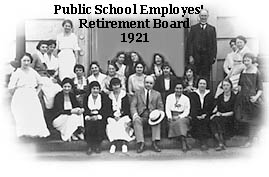
1917 The Pennsylvania Public School Employees’ Retirement Act became law on July 18.
1918 Henry H. Baish became the System’s first Secretary. The first Board was comprised of seven members.
1919 The law went into full effect July 1 with the merger of 13 school district retirement systems into the new statewide System. Membership was 37,503.
1920 By July, 204 members had been granted full retirement and 50 had been granted disabilities. The average annuity was $275 a year.
1920 to 1923 The Institute for Government Research called PSERS one of the nation’s "safe and sound systems." (Ninety percent of the country’s systems were found to be unsafe.)
1924 PSERS membership had grown to 54,677. The balance in the retirement fund was $7.3 million. 1929 Membership totaled 71,313. Funds were invested exclusively in Pennsylvania state, county, city, borough, and township bonds with preference for school district bonds. The System was not threatened by the "Crash."
1933 Membership had grown to 74,698. U.S. government bonds were added to the list of legal investments.
1935 At the height of the depression, the year’s annual report noted that through PSERS’ bond investments, jobs had been created building schools and roads in Pennsylvania.
1941 to 1942 Even with nationwide conscription to fight a war on two fronts, PSERS membership grew from 82,956 to 83, 482.
1944 The System’s first Secretary, Mr. Baish, left after 25 years. He was succeeded by J. Y. Shambach.
1950 Mr. Shambach was replaced by Dr. George C. Richwine who served as acting Secretary until 1953. At mid-century, membership was 91,000, with assets of $576.7 million.
1953 Rex T. Wrye was appointed as Secretary.
1963 The minimum benefit paid to retirees became $100 a month.
1967 The first ad hoc cost-of-living adjustment was granted; subsequent adjustments were granted in 1974, 1979, 1984, and 1989.
1970 Mr. Wrye died and was succeeded by Frank R. Cashman as executive director. Annuitants totaled 32,140 with an annual payroll of $104 million. The basic benefit formula increased to 2 percent of final average salary. The system’s computerization began.
1972 The first report was presented by the actuary hired for the examination of the actuarial soundness of the Fund.
1973 A field staff was formed with offices around the state to counsel members and to instruct reporting units. 1974 Final average salary was redefined as average compensation in the highest three periods of 12 consecutive months.
.